Chicken Marbella, does it sound Spanish? Well, it isn’t! It was created in New York City by two trailblazing female chefs.
This post is an adaptation of the iconic ‘Silver Palate’ recipe. I exercised some creative license and took this recipe a little further down the Mediterranean coast towards the Middle East. Date syrup was used in lieu of brown sugar, and I swapped out the prunes for dates. There are a few other tweaks which you will see in the recipe.
Before I fiddle with an iconic recipe (or any recipe) I like to make it ‘as it is written’ at least a couple times. The original recipe is truly a delight and I still make it ‘properly’ on occasion. My family love Middle Eastern flavours so my little tweaks or adaptations managed to slide the flavour profile slightly over to the Middle East.
This recipe, as well as the original recipe are super easy to make. The chicken is marinated overnight then prior to cooking you add some wine (or a suitable substitute), and brown sugar (or in this versions case, date syrup). It is easy to make for a big crowd and the flavour is spectacular. It is truly one of the most delicious chicken dishes. Perfect for entertaining at a big banquet, buffet style, or just a solid delicious family meal.
Here is a little background of the origins of the original chicken Marbella:
Chicken Marbella was created by two very talented, prolific, and influential American chefs in the late 1970s, Sheila Lukins and Julee Rosso. This dish was born at the Silver Palate gourmet shop in Manhattan, New York City, it is an American recipe through and through. These women later published a cookbook, ‘The Silver Palate Cookbook’ in 1982. Chicken Marbella was one of the breakout stars of the soon to be iconic cookbook.
Did you know that if you hit the ❤️ at the top or bottom of this post, it makes it easier for people to find us all at Just really good recipes!
If you enjoy what you read, please consider upgrading to a PAID subscription, it helps support my work here at Just really good recipes.
This cookbook had a devout cult like following, and it was so very chic if you cooked Silver Palate recipes. My mother still has this cookbook in her collection (I must remember to permanently borrow it from her one of these days. She doesn’t cook from it anymore so I am sure she will happily donate it to my growing collection). The Chicken Marbella recipe became one of the most popular dinner party dishes in the 1980s. The recipe pays homage (at least I would think it does) to the Spanish town, Marbella, on the Mediterranean coast.
The whole vibe of this recipe is very glamorous, and influenced by the coastal freshness of the Mediterranean. Chicken Marbella truly lives up to the concept of fusion cooking done well.
This post has the original recipe from ‘The Silver Palate Cookbook’, and also my spin (adaptation) on this 1980s classic. When you are adventurous in your home kitchen, sometimes you win and other times you crash, and literally burn. My twists for this recipe are solidly in the win column - at least the ones I am sharing!
First twist on this recipe, I don’t often use prunes*, I use dates, it is a 1:1 swap - I always have dates lying around ready for duty. Another addition/twist to the original recipe is a generous amount of lemon zest is added to the marinade for some brightness and exotic flair. A bit of zest is also grated over the dish just prior to baking for an extra citrusy hit. I also don’t use white wine, I just add a bit (3/4 cup) of chicken broth with 1 tsp apple cider vinegar, and if need be adjust the seasoning. Another twist/adaptation is to use Lebanese green olives** if I don’t happen to have Spanish olives - the final dish is just as delicious. I love this about cooking, when you know what you like, it becomes easy to add your stamp to a recipe - even the iconic recipes.
*Notes on prunes:
They are dried plums. I adore Persian prunes. IFF Persian prunes are in my pantry, they are definitely being used above all. Persian prunes can be difficult to source, they usually need to be ordered. If ever you see them in your travels, grab them! Persian prunes can be golden in colour - there are several species, some are darker. Western prunes are black. The Persian variety are also drier, less sugar, and have a lovely sour (with a bit of sweet) flavour profile. Persian prunes are perfect for stews, and in this recipe they are sensational.
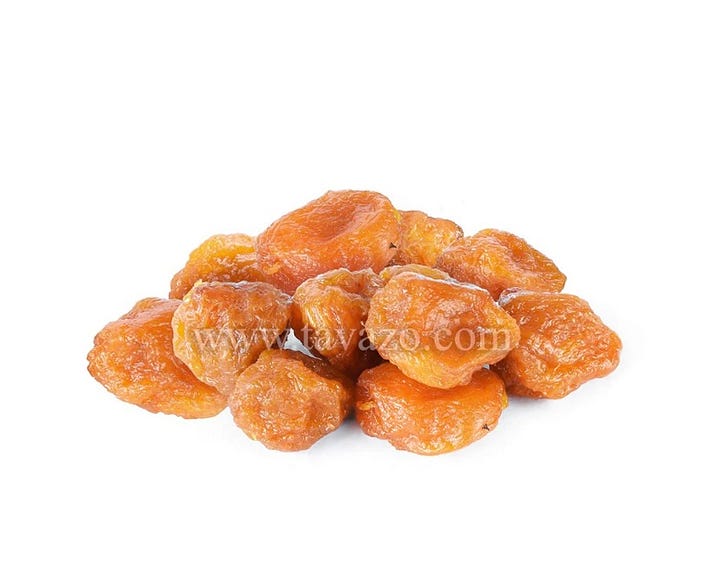
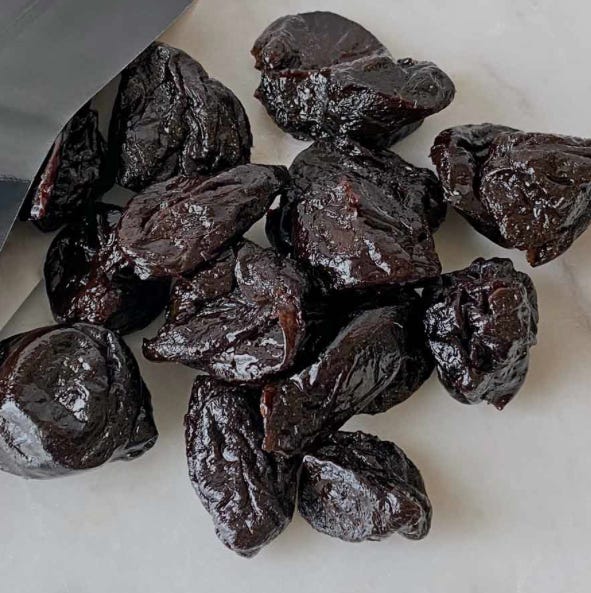
For this recipe’s purposes if you are considering prunes versus dates. In general, prunes are moister, less sticky and have a less sweet flavour. Dates taste sweeter, and when cooked have almost a caramel-like profile. I love dates together with the salty olives, and the vibrant lemon zest, I think it is the perfect bite. This chart was found in my travels and I am including it for interest. For cooking/baking dates and prunes are easily interchangeable, 1:1 swap.
**Notes on Lebanese olives versus Spanish olives
The main idea is to use pitted green olives. Olives are a pretty controversial topic for many, especially those that live in an olive producing region. I live in a Northern climate that does not support olive production, and I have not met an olive I didn’t love - extra olives were added to this recipe to suit our palates! I use different green olives varieties interchangeably in many and for many applications. If you have been reading my previous posts, you already know I am semi-feral and fearless in my culinary pursuits - from the comfort of my home kitchen!
Spanish olives are plump, soft and round - perfect for cocktails, tapas and classic Spanish dishes. Lebanese olives are smaller, often an irregular oval shape and quite firm. Lebanese olives can also vary in flavour depending on the brine and often heavy use of fresh herbs. Spanish olives are mild, fleshy, salty and consistent in flavour. Lebanese olives tend to lean towards tangy and bitter and chewy. They also have a rustic bold flavour. For this recipe, both varieties work beautifully, use what you like - you won’t be disappointed.
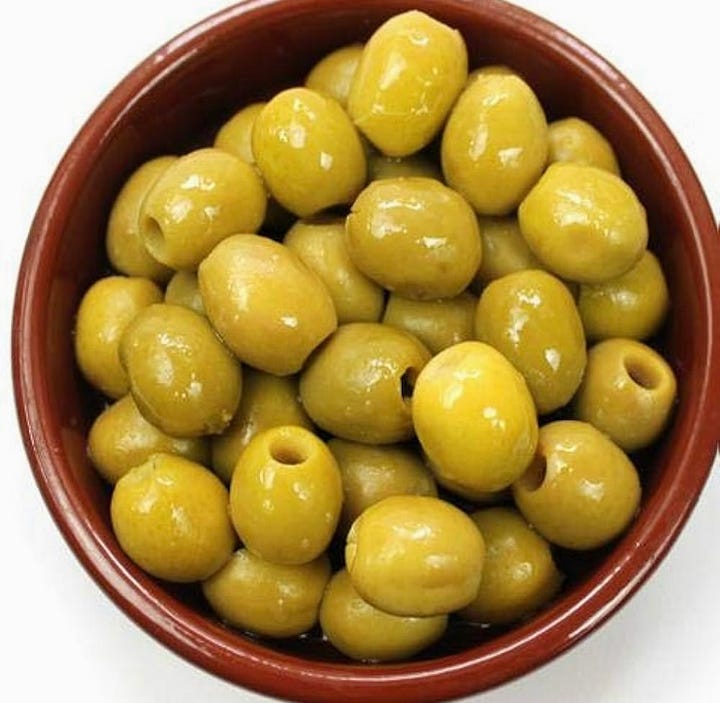
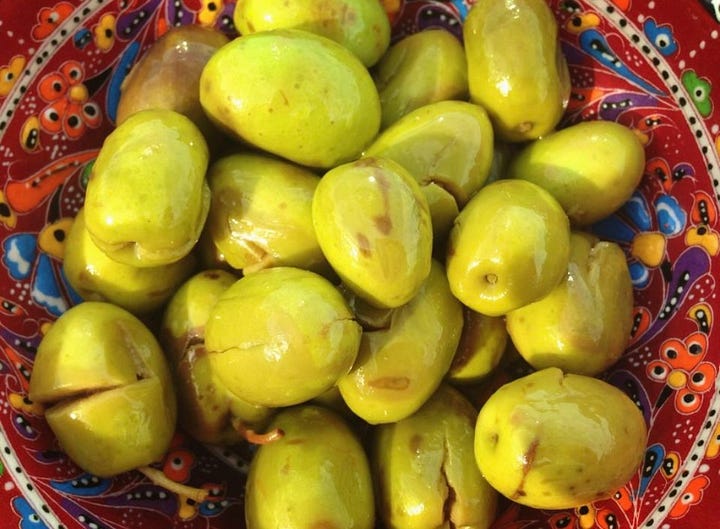
CLASSIC CHICKEN MARBELLA RECIPE (from The Silver Palate Cookbook)
Ingredients:
Original recipe:
4 chickens (2½ pounds each), quartered (may use just bone-in thighs, legs or both).
This recipe:
bone-in chicken thighs and drums. About 18 pieces.
Feel free to use boneless. I used chicken thighs with no skin, the drums had skins - you decide skins or no skins! If you prefer boneless, just cut down on the cook time.
Marinade
1 head of garlic, peeled and finely chopped (or grated, try using a garlic press)
¼ cup dried oregano
Salt and black pepper to taste - start with 2 tsp salt and ½ pepper
½ cup red wine vinegar
½ cup extra virgin olive oil
¼ cup capers with a bit of juice - I only add ¼ cup
6 bay leaves
1½ cups pitted prunes OR 1 - 1½ cups pitted dates (I use dates unless I have Persian prunes - see note* above about prunes versus dates)
1 cup (or more to taste) pitted Spanish green olives - I often use pitted green Lebanese olives (see note** above for an olive comparison)
Zest of 1 lemon for the marinade- not in the original recipe, my twist
The rest of the recipe
½ - 1 cup brown sugar OR date syrup - the sugar is used to top the chicken prior to baking, use your discretion. If using date syrup, simply drizzle generously over the chicken prior to baking in the oven.
1 cup white wine - I don’t add wine, instead I use 3/4 cup of chicken broth with 1 tsp apple cider vinegar (or white wine vinegar)
More lemon zest just prior to baking - a sprinkling over the dish will suffice
Garnish
¼ cup fresh parsley or cilantro, finely chopped (for garnish)
Method:
1. Marinate (optimally the day before):
In a large bowl or baking dish, combine chicken with garlic, oregano, salt, pepper, vinegar, olive oil, prunes, olives, capers, lemon zest and bay leaves. Cover and refrigerate overnight. Alternatively, use a big Ziploc type bag. Add the marinating components, and then the chicken.
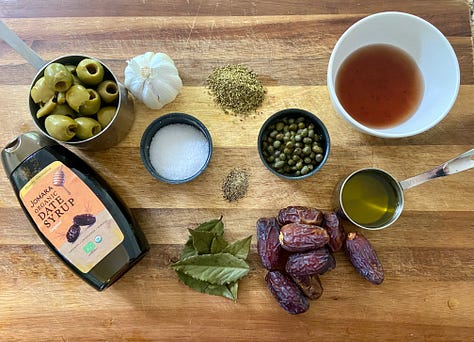
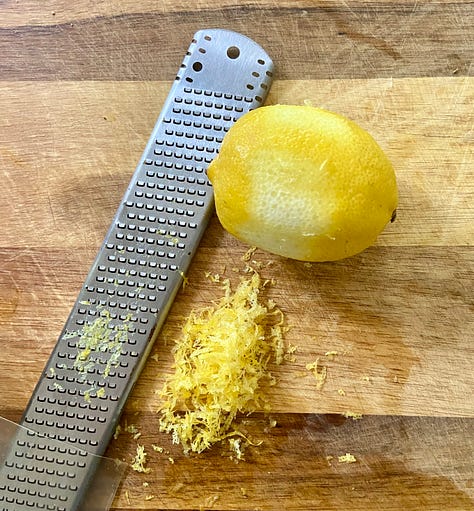

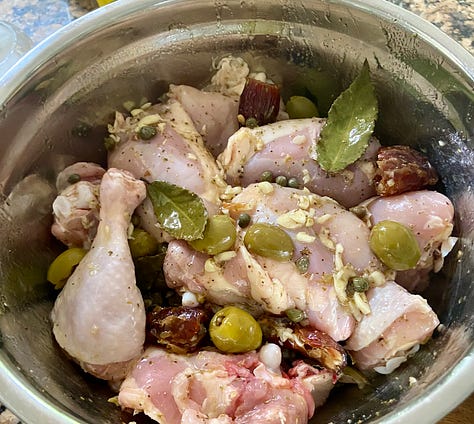

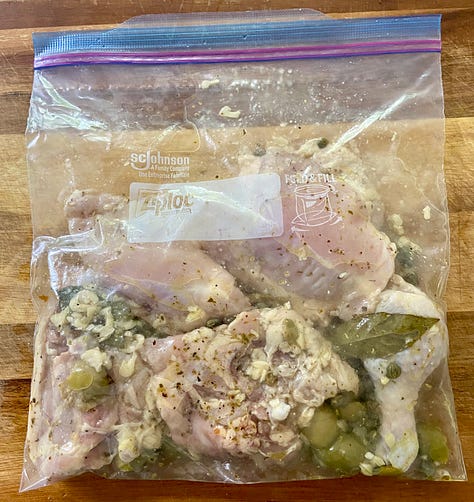
2. Preheat oven to 350°F (175°C).
Arrange chicken in a single layer in one (or two) large shallow baking dishes/pans. Spoon marinade over the chicken. Sprinkle chicken pieces with the brown sugar (or drizzle with date syrup), lightly add more lemon zest to the top, then pour the white wine (or broth and vinegar) around the chicken.
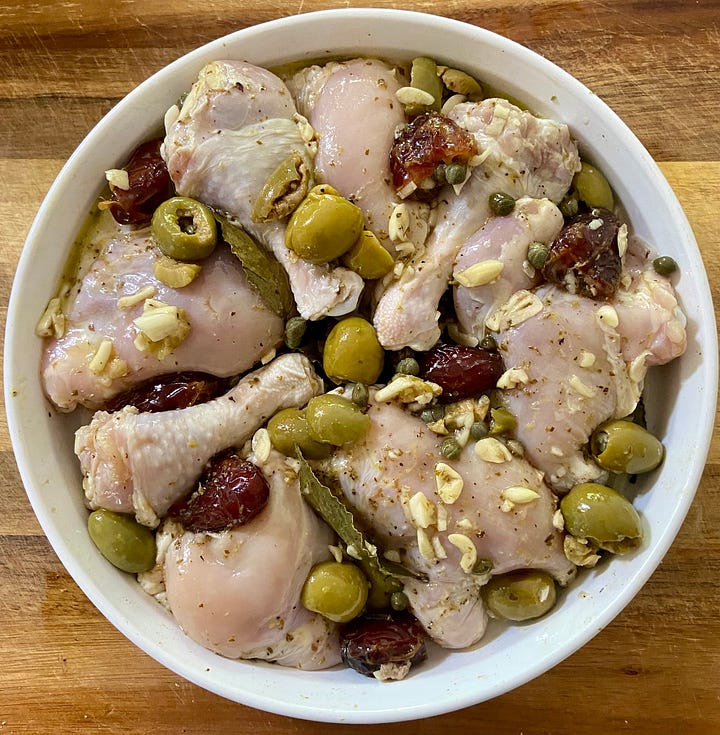
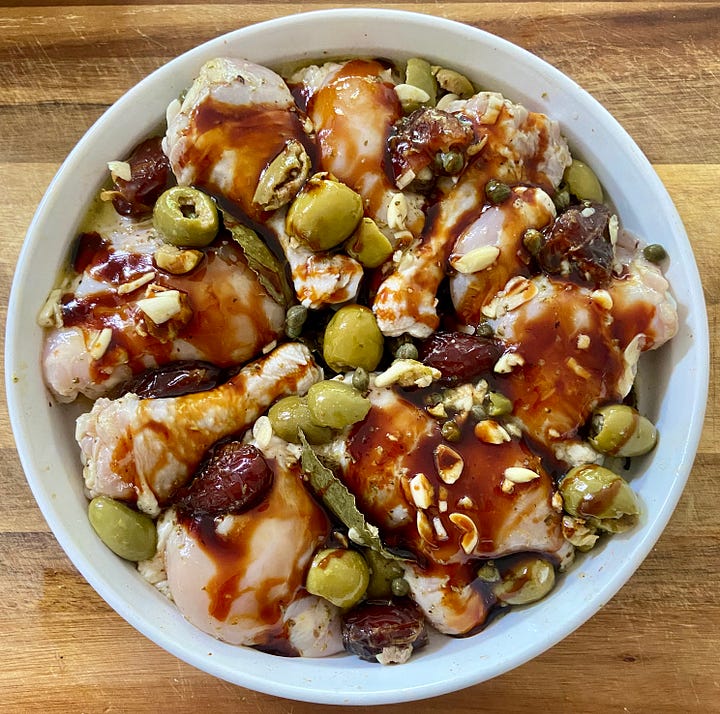
3. Cook:
Bake for 50 minutes to 1 hour, basting frequently with pan juices.
Chicken is done when it’s golden brown and juices run clear internal temp will be at least 165 F.
4. Serve:
Garnish with finely chopped parsley or cilantro.


Serve and enjoy!





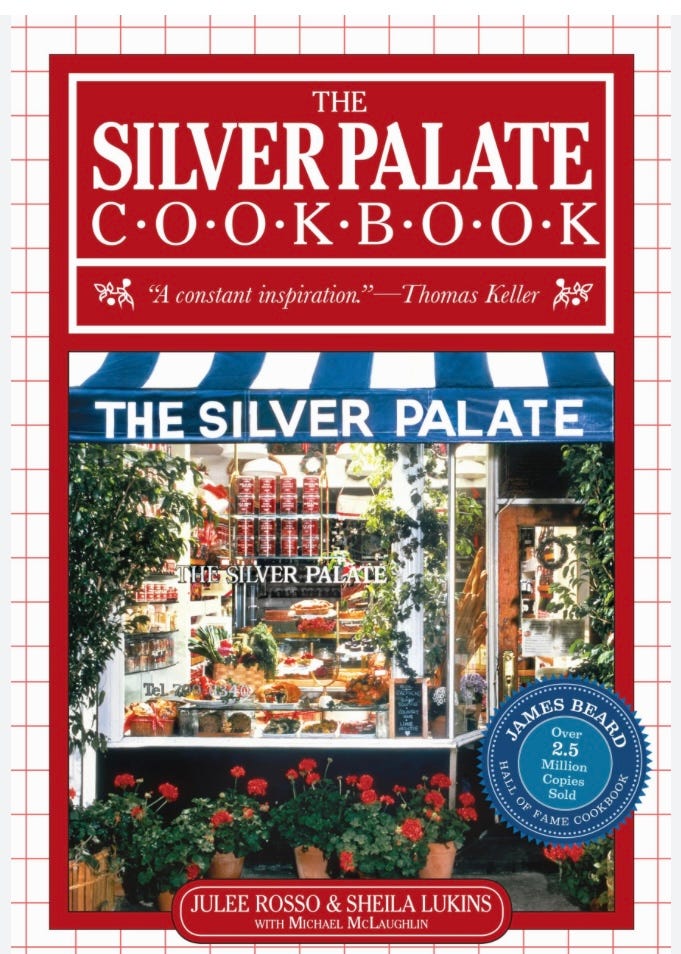
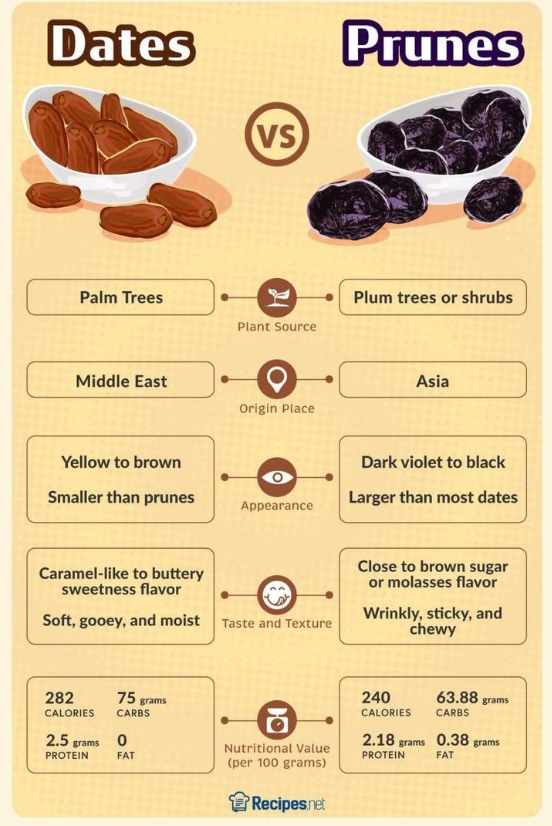
This looks fantastic and although I was around in the 80's I don 't remember ever having it. Chicken Cacciatore was my go to chicken dish with Rotel® tomatoes and green chilis. I still make it today.
Beautiful